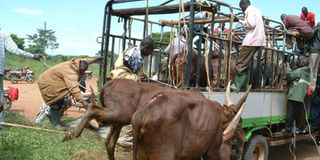Why foot and mouth disease is still rampant

Transportation. Cattle traders load animals on a truck at Wabigalo Sub-county in Nakasongola District before the quarantine was imposed. Photo by Dan Wandera
What you need to know:
- Suggestion. Leaders urge government to ensure that there is enough manpower to conduct surveillance on borders.
- Foot-and-mouth disease is a highly infectious disease of cloven hoofed animals characterised by the formation of vesicles in and around the mouth and on the feet.
Nakaseke/Nakasongola. Leaders in the cattle corridor districts of Nakasongola, Nakaseke and Luweero have blamed the constant outbreak of foot and mouth disease (FMD) on porous borders.
The leaders claim some infected animals are smuggled into the country from Tanzania.
Livestock farmers in the districts and other cattle corridor areas have suffered unending outbreak of FMD since 2015, prompting government to place them under quarantine.
“We have fallen victim to the porous borders, including the one between Tanzania and Uganda, especially Bugango border post in Isingiro District where animals believed to be infected with FMD enter the country and end up in Nakaseke,” Mr Johnson Kamuhangire, a councillor representing people with disabilities in Nakaseke, says.
“It was discovered by our veterinary staff that some of these animals were infected with FMD,” he adds.
Mr Kamuhangire says check points where transporters are supposed to present vaccination certificates are evaded by unscrupulous traders who use porous routes. “The number of police officers we have cannot sustain an effective monitoring system for individuals evading check points. We also have senior government officials who take advantage of their offices and positions to intimidate officials at the check points,” he says.
The most hit areas are; Ngoma Town Council, Ngoma, Kinyogoga, Kinoni and Kikamulo sub-counties.
The Nakaseke vice chairperson, Mr Richard Mavuuma, says there are also incidents where the ministry of Agriculture has acted on rumours to hurriedly sanction quarantine without consulting district leaders.
Mr Charles Peter Kamunda, a cattle farmer in Ngoma, says some traders are profiting from the quarantines.
“Unscrupulous traders smuggle in the affected animals to sustain the quarantine for a longer period. They later buy off the animals at very cheap prices and sell them at normal market prices in Kampala,” Mr Kamunda says.
He says traders buy off animals between Shs300,000 and Shs400,000 and later sell them at about Shs1.5m.
The district veterinary officer, Dr Moses Ssekandi, says government is yet to lift the cattle quarantine imposed on Ngoma, Kinoni and Kinyogoga sub-counties despite pleas from farmers.
The Nakasongola chairperson, Mr Sam Kigula, claims the district is used as a transit route for animals from Masindi, Nakaseke, Luweero, Kiryandongo and other districts in northern Uganda.
“Most of these animals did not go through the check points for verification. This partly explains why the FMD persists in our area. Government should reinforce the veterinary teams and ensure that there is enough manpower to conduct the surveillance and arrest people flouting the guidelines,” Mr Kigula says.
However, the State Minister for Animal Husbandry, Ms Joy Kabatsi, says government has boosted surveillance on the Uganda-Tanzania border, adding that no cattle are allowed to cross to Uganda.
“We are not seated as they [livestock farmers] think. We have put up measures because we are also aware that some FMD infected animals come from our neighbours in Tanzania. Both police and the army are monitoring various border points to ensure that we contain this problem,” Ms Kabatasi says.
Efforts to speak to Minister in charge of East African Affairs Kirunda Kivejinja were futile as his known telephone was switched off.
Losses
Foot-and-mouth disease is a highly infectious disease of cloven hoofed animals characterised by the formation of vesicles in and around the mouth and on the feet. A recent survey by Mbarara Zonal Agricultural Research and Development Institute revealed that more than 350,000 head of cattle died of FMD, which was confirmed in 63 districts since October last year. The survey also indicated that the meat value chain is estimated to be losing 23 per cent of potential income due to the outbreak.




